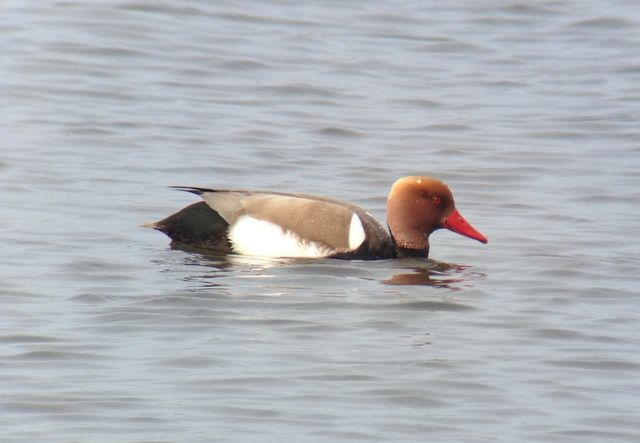Day 1 of a long weekend of tours today and we headed up to the North-West Norfolk coast. It was cloudy in the morning, sunny later on but dry and warm all day with a light northerly wind.
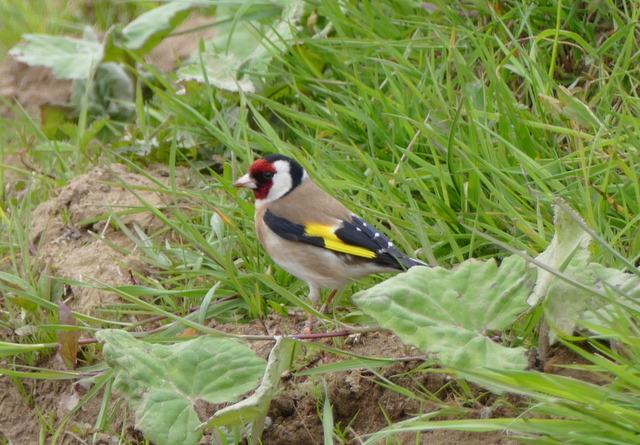 Goldfinch – coming down to feed on dandelion heads by the road at Choseley
Goldfinch – coming down to feed on dandelion heads by the road at Choseley
The Dotterel have been in the fields at Choseley for about three weeks now, though exact numbers have varied from day to day. That was our first post of call today and they were in their usual field. They were distant at first, but we walked along the track towards the drying barns and while we were doing so, they started to run closer. There were other birds in the hedgerows as well – a couple of Goldfinch came down to feed on the dandelion clocks by the road, a bright male Yellowhammer sang from the top of a hawthorn and a Lesser Whitethroat rattled from the hedge nearby. There were lots of Brown Hares in the field too.
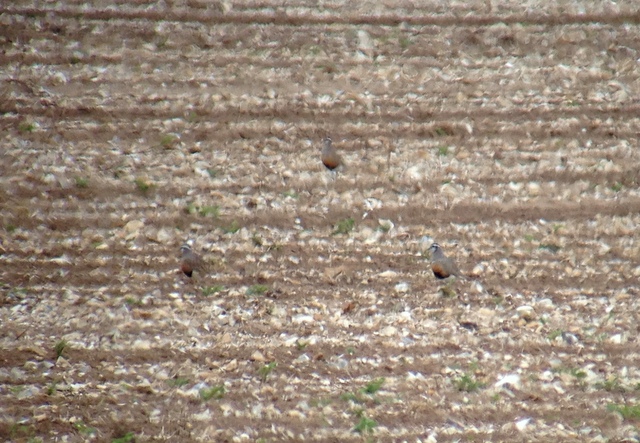 Dotterel – three of the 22+ at Choseley today
Dotterel – three of the 22+ at Choseley today
The Dotterel were hard to count. When they stop and crouch they do a very good impression of stones in the field! They were also split into two groups. The group that came towards us included 19 birds and at least 3 more were over the other side of the field, making a minimum of 22 in total. A very good size trip indeed. We spent some time watching them running around, the females with their bright orange and dark chestnut bellies, white breast stripe and bright white superciliums, and the duller-looking males. Smart birds.
We drove round to the drying barns afterwards, stopping on the way to admire various things. Our first Wheatear of the day, a female, was perched on top of a rock on the bare earth beside the road. There is no shortage of Red-legged Partridges here, but a single male Grey Partridge was feeding quietly close to one of the hedges. We had even better views of two pairs of Grey Partridge later on, opposite the drying barns. But on our way there, we stopped to look at a Corn Bunting singing from the wires, and to listen to its song, like jangling keys.
 Corn Bunting – singing from the wires by the road
Corn Bunting – singing from the wires by the road
From there, we drove over to Holme and walked out past the golf course to the paddocks. There were lots of Whitethroats singing from the bushes, and several Blackcaps as well. We could hear a Turtle Dove purring from the trees nearby, but we couldn’t see it. However, we did see one more distantly, performing a song flight the other side of the houses along the access road. We decided to go for a walk and try again on our way back. There were a few butterflies on the wing, despite the cloud and light breeze, with several Wall and a single Green Hairstreak the most notable.
 Wall – there were several of these butterflies in the dunes today
Wall – there were several of these butterflies in the dunes today
As we walked towards the dunes, we stopped to scan the grazing marshes across the road. Down in the grass were a couple of cracking male Greenland Wheatears, sporting a wash of burnt orange across the throat and upper breast.A female Wheatear was feeding on the short grass in the dunes further along. There were lots of Swifts up in the sky above, making their way slowly west. A pair of Marsh Harriers circled up, pursued by all and sundry – Jackdaws, Lapwings and Avocets. There were Curlews on the beach, Redshanks on the saltmarsh, and we flushed a Common Sandpiper from the edge of one of the puddles. We got half way through the dunes before it was time to head back.
Back at the paddocks, a bubbling call from the bushes alerted us to the presence of a female Cuckoo. We stopped for a second and eventually she flew out past us and away towards the houses, giving us great flight views as she went. At the far end, we could hear the Turtle Dove purring again, from the trees, but we still couldn’t see it at first. However, waiting patiently for a short while and it flew out and landed in the tops of the trees, where we could get it in the scope for all to see. As we walked back to the car, we could hear the Turtle Dove purring all the way.
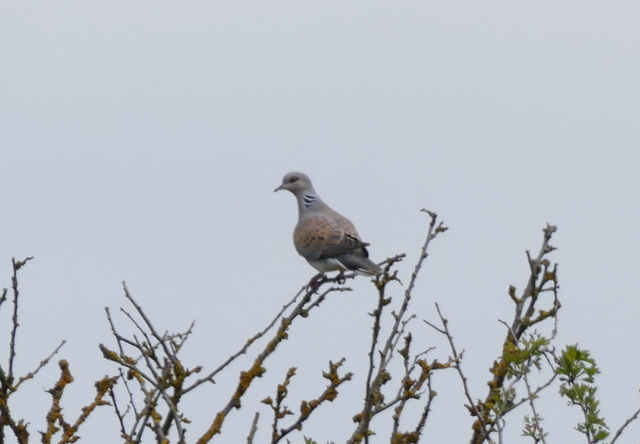 Turtle Dove – purring in the paddocks at Holme
Turtle Dove – purring in the paddocks at Holme
After lunch, we drove back to Titchwell. On the walk out to the reserve, we stopped to listen to a Grasshopper Warbler reeling from the Thornham grazing marsh. There were several Reed Warblers singing, appropriately enough, from the reeds, but the Sedge Warblers were a little more reticent today. We heard snatches of song and saw them moving around from bush to bush. The Cetti’s Warblers were as noisy, and as secretive, as ever.
We picked up our first House Martins of the day over the reedbed. There were lots of them, flying back and forth, feeding, as well as several Swallows. As we watched them, they started to trickle off west over the bank. There were loads of Swifts here too.
Scanning the Freshmarsh from Island Hide, we could see a good selection of waders. A little throng of smaller waders on one of the closer islands caught the eye first, with a mixture of mostly Dunlin and Ringed Plover, about 15 of each. Many of the Dunlin were in summer plumage, with rusty-toned upperparts and sporting smart black belly patches. The Ringed Plover were a bit smaller and darker than our regular breeding birds – these were Tundra Ringed Plover (subspecies tundrae), stopping off on their way to breeding grounds further north. Behind them were a couple of beautiful summer plumage Turnstones, with rusty-orange backs and white faces, while a little huddle of around 20 had gathered on one of the islands further back.
Equally smart, was a stunning summer plumage Grey Plover nearby, sporting a very fetching black belly, breast and face. There are not so many Black-tailed Godwit here at the moment, but a single rusty-coloured summer plumaged bird certainly drew our attention. Not far away, a small group of Bar-tailed Godwits were mostly asleep. The majority were still in grey-brown winter plumage, but a couple of them were equally rusty-coloured, if not more so. No trip to Titchwell would be complete without a stop to admire the Avocets.
 Avocet – showing well from Island Hide, as usual
Avocet – showing well from Island Hide, as usual
There were several Common Terns around the freshmarsh, plus plenty of gulls. Herring Gulls of varous ages were mostly asleep, along with a few young Common Gulls. However, amongst them, a couple of gulls instantly stood out. They were clearly much smaller, and they were swimming round in circles, picking at insects on the water’s surface, Little Gulls. Scanning across and another couple were over to towards the reeds. These were immature birds, 1st summers, most of them sporting a patchy black hood to a greater or lesser degree, but with black markings in the wings which showed as an inverted ‘w’ pattern when they flew.
 Little Gull – 2 of the 4 on the freshmarsh today
Little Gull – 2 of the 4 on the freshmarsh today
From round at the Parrinder Hide, we finally located the prize birds of the freshmarsh today – two Temminck’s Stints. They were feeding very furtively on one of the muddy islands, close to or amongst the emerging vegetation, and when they felt threatened they crouched down. They were so well camouflaged, with their brown colours, they were very hard to see against the mud. Nearby, we admired the golden eye-rings on a couple of Little Ringed Plover.
The number of ducks continues to decline, but there was a single drake Wigeon on the freshmarsh today, although the Teal seem to have disappeared. The Mallard already have lots of ducklings and there were still several Shoveler and plenty of Gadwall. Brent Goose numbers also appear to be dropping now, with only a very small number coming in to the freshmarsh to bathe today.
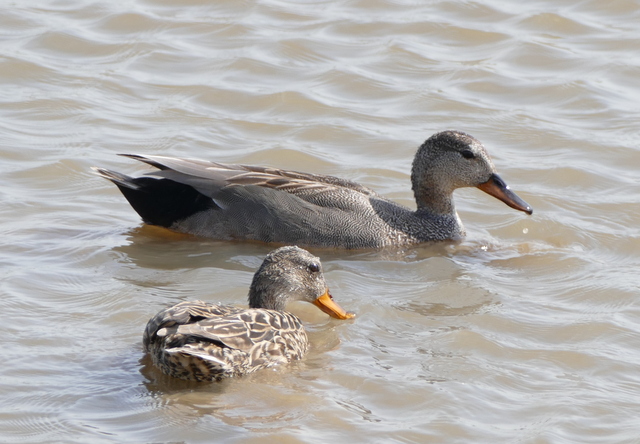 Gadwall – the connoisseur’s duck
Gadwall – the connoisseur’s duck
The tide was high this afternoon, which was why several of the waders had gathered on the freshmarsh. There was very little on the Volunteer Marsh, except a single Little Egret.
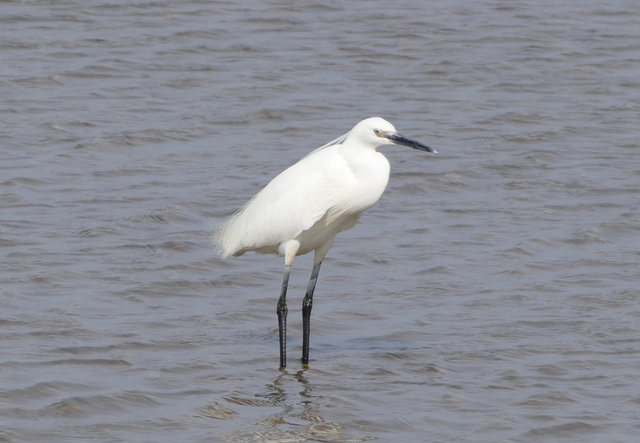 Little Egret – by the path on the Volunteer Marsh
Little Egret – by the path on the Volunteer Marsh
Four Little Terns had dropped in to the freshmarsh to bathe while we were in Parrinder Hide, and when they landed beside a couple of Common Terns, gave us a good size comparison so we could see just how small they are. However, a couple of Little Terns were on the mud on the tidal pools close to the path and we got even better, close-up views through the scope. We also watched one of them fishing nearby, hovering and dropping down to splash into the water. The beach was fairly quiet today, with the tide in, but we did see a couple of Sandwich Terns offshore.
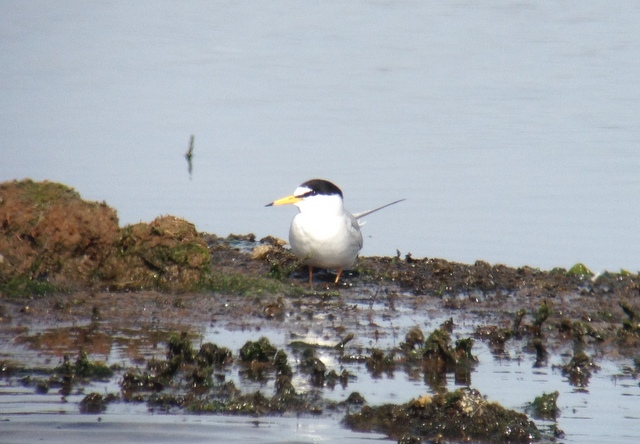 Little Tern – great scope views on the tidal pools today
Little Tern – great scope views on the tidal pools today
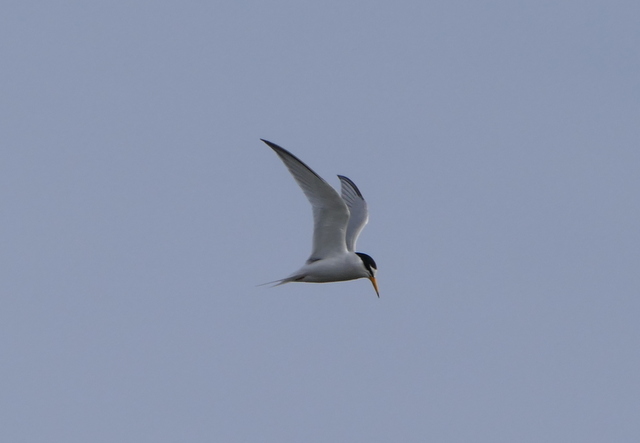 Little Tern – 1 was fishing right by the path
Little Tern – 1 was fishing right by the path
As we walked back from the beach, past the freshmarsh, a Hobby flashed by and zoomed out across the saltmarsh. We had also seen a Peregrine earlier, when we were watching the Temminck’s Stints on the way out, and as we passed Island Hide, we picked it up again, circling high over the edge of the reedbed.
We just had enough time for a quick look at Patsy’s Reedbed. Willow Warblers were singing from the sallows on the walk out there. This has been the most reliable place in recent weeks to catch up with the Red-crested Pochard and we were not to be disappointed today. Three drakes were feeding directly in front of the screen and another pair were right over the back of the pool. Then it was time to call it a day and head back.
